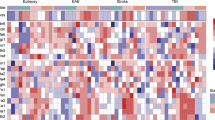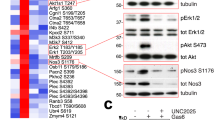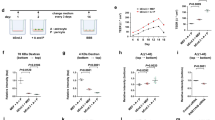Abstract
The blood-brain barrier (BBB) is an integral part of the neurovascular unit (NVU). The NVU is comprised of endothelial cells that are interconnected by tight junctions resting on a parenchymal basement membrane ensheathed by pericytes, smooth muscle cells and a layer of astrocyte end feet1. Circulating blood cells, such as leukocytes, complete the NVU2. BBB disruption is common in several neurological diseases, but the molecular mechanisms involved remain largely unknown3. We analyzed the role of TWIK-related potassium channel-1 (TREK1, encoded by KCNK2) in human and mouse endothelial cells and the BBB. TREK1 was downregulated in endothelial cells by treatment with interferon-γ (IFN-γ) and tumor necrosis factor-α (TNF-α). Blocking TREK1 increased leukocyte transmigration, whereas TREK1 activation had the opposite effect. We identified altered mitogen-activated protein (MAP) kinase signaling, actin remodeling and upregulation of cellular adhesion molecules as potential mechanisms of increased migration in TREK1-deficient (Kcnk2−/−) cells. In Kcnk2−/− mice, brain endothelial cells showed an upregulation of the cellular adhesion molecules ICAM1, VCAM1 and PECAM1 and facilitated leukocyte trafficking into the CNS. Following the induction of experimental autoimmune encephalomyelitis (EAE) by immunization with a myelin oligodendrocyte protein (MOG)35–55 peptide, Kcnk2−/− mice showed higher EAE severity scores that were accompanied by increased cellular infiltrates in the central nervous system (CNS). The severity of EAE was attenuated in mice given the amyotrophic lateral sclerosis drug riluzole or fed a diet enriched with linseed oil (which contains the TREK-1 activating omega-3 fatty acid α-linolenic acid). These beneficial effects were reduced in Kcnk2−/− mice, suggesting TREK-1 activating compounds may be used therapeutically to treat diseases related to BBB dysfunction.
This is a preview of subscription content, access via your institution
Access options
Subscribe to this journal
Receive 12 print issues and online access
$209.00 per year
only $17.42 per issue
Buy this article
- Purchase on Springer Link
- Instant access to full article PDF
Prices may be subject to local taxes which are calculated during checkout




Similar content being viewed by others
References
Neuwelt, E.A. et al. Engaging neuroscience to advance translational research in brain barrier biology. Nat. Rev. Neurosci. 12, 169–182 (2011).
Holman, D.W., Klein, R.S. & Ransohoff, R.M. The blood-brain barrier, chemokines and multiple sclerosis. Biochim. Biophys. Acta 1812, 220–230 (2011).
Weiss, N., Miller, F., Cazaubon, S. & Couraud, P.O. The blood-brain barrier in brain homeostasis and neurological diseases. Biochim. Biophys. Acta 1788, 842–857 (2009).
Overington, J.P., Al-Lazikani, B. & Hopkins, A.L. How many drug targets are there? Nat. Rev. Drug Discov. 5, 993–996 (2006).
Honoré, E. The neuronal background K2P channels: focus on TREK1. Nat. Rev. Neurosci. 8, 251–261 (2007).
Heurteaux, C. et al. Deletion of the background potassium channel TREK-1 results in a depression-resistant phenotype. Nat. Neurosci. 9, 1134–1141 (2006).
Alloui, A. et al. TREK-1, a K+ channel involved in polymodal pain perception. EMBO J. 25, 2368–2376 (2006).
Heurteaux, C., Laigle, C., Blondeau, N., Jarretou, G. & Lazdunski, M. α-linolenic acid and riluzole treatment confer cerebral protection and improve survival after focal brain ischemia. Neuroscience 137, 241–251 (2006).
Mazella, J. et al. Spadin, a sortilin-derived peptide, targeting rodent TREK-1 channels: a new concept in the antidepressant drug design. PLoS Biol. 8, e1000355 (2010).
Wang, Q. & Doerschuk, C.M. The signaling pathways induced by neutrophil-endothelial cell adhesion. Antioxid. Redox Signal. 4, 39–47 (2002).
Garry, A. et al. Altered acetylcholine, bradykinin and cutaneous pressure–induced vasodilation in mice lacking the TREK1 potassium channel: the endothelial link. EMBO Rep. 8, 354–359 (2007).
Namiranian, K. et al. Cerebrovascular responses in mice deficient in the potassium channel, TREK-1. Am. J. Physiol. Regul. Integr. Comp. Physiol. 299, R461–R469 (2010).
Duprat, F. et al. The neuroprotective agent riluzole activates the two P domain K+ channels TREK-1 and TRAAK. Mol. Pharmacol. 57, 906–912 (2000).
Gilgun-Sherki, Y., Panet, H., Melamed, E. & Offen, D. Riluzole suppresses experimental autoimmune encephalomyelitis: implications for the treatment of multiple sclerosis. Brain Res. 989, 196–204 (2003).
Nordøy, A. Dietary fatty acids and coronary heart disease. Lipids 34 (suppl.), S19–S22 (1999).
Lauritzen, I. et al. Polyunsaturated fatty acids are potent neuroprotectors. EMBO J. 19, 1784–1793 (2000).
Nguemeni, C. et al. Dietary supplementation of α-linolenic acid in an enriched rapeseed oil diet protects from stroke. Pharmacol. Res. 61, 226–233 (2010).
Lauritzen, I. et al. Cross-talk between the mechano-gated K2P channel TREK-1 and the actin cytoskeleton. EMBO Rep. 6, 642–648 (2005).
Heurteaux, C. et al. TREK-1, a K+ channel involved in neuroprotection and general anesthesia. EMBO J. 23, 2684–2695 (2004).
Bittner, S. et al. TASK1 modulates inflammation and neurodegeneration in autoimmune inflammation of the central nervous system. Brain 132, 2501–2516 (2009).
Schneider-Hohendorf, T. et al. Regulatory T cells exhibit enhanced migratory characteristics, a feature impaired in patients with multiple sclerosis. Eur. J. Immunol. 40, 3581–3590 (2010).
Göbel, K. et al. Blockade of the kinin receptor B1 protects from autoimmune CNS disease by reducing leukocyte trafficking. J. Autoimmun. 36, 106–114 (2011).
Huang, Y.H. et al. Specific central nervous system recruitment of HLA-G+ regulatory T cells in multiple sclerosis. Ann. Neurol. 66, 171–183 (2009).
Kleinewietfeld, M. et al. CCR6 expression defines regulatory effector/memory-like cells within the CD25+CD4+ T-cell subset. Blood 105, 2877–2886 (2005).
Schuhmann, M.K. et al. Stromal interaction molecules 1 and 2 are key regulators of autoreactive T cell activation in murine autoimmune central nervous system inflammation. J. Immunol. 184, 1536–1542 (2010).
Bittner, S. et al. Upregulation of K2P5.1 potassium channels in multiple sclerosis. Ann. Neurol. 68, 58–69 (2010).
Dodt, H.U. & Zieglgansberger, W. Visualizing unstained neurons in living brain slices by infrared DIC-videomicroscopy. Brain Res. 537, 333–336 (1990).
Moha ou Maati, H. et al. A human TREK-1/HEK cell line: a highly efficient screening tool for drug development in neurological diseases. PLoS ONE 6, e25602 (2011).
Duprat, F. et al. The neuroprotective agent riluzole activates the two P-domain K+ channels TREK-1 and TRAAK. Mol. Pharmacol. 57, 906–912 (2000).
Moha ou Maati, H. et al. Spadin as a new antidepressant: absence of TREK-1-related side effects. Neuropharmacology 62, 278–288 (2011).
De Bock, M. et al. Low extracellular Ca2+ conditions induce an increase in brain endothelial permeability that involves intercellular Ca2+ waves. Brain Res. 1487, 78–87 (2012).
Bettelli, E. et al. Myelin oligodendrocyte glycoprotein-specific T cell receptor transgenic mice develop spontaneous autoimmune optic neuritis. J. Exp. Med. 197, 1073–1081 (2003).
Krishnamoorthy, G., Holz, A. & Wekerle, H. Experimental models of spontaneous autoimmune disease in the central nervous system. J. Mol. Med. (Berl) 85, 1161–1173 (2007).
Williams, J.L. et al. Memory cells specific for myelin oligodendrocyte glycoprotein (MOG) govern the transfer of experimental autoimmune encephalomyelitis. J. Neuroimmunol. 234, 84–92 (2011).
Dixon, W. & Massey, F. Introduction to Statistical Analysis (McGraw-Hill Companies, New York, 1969).
Acknowledgements
This work was supported by the Deutsche Forschungsgemeinschaft (SFB TR128, TP B1 to H.W., SFB TR128, TP B6 to S.G.M., T.B. and H.-C.P.; SFB 1009, TP A3 to H.W.; FOR1086, TP2 to T.B. and S.G.M.; ME3283/2-1 to S.G.M.; and SFB688 TP A13 to C.K.), the Bundesministerium für Bildung und Forschung (Kompetenznetzwerk Multiple Sclerosis, 01GI0907 to H.W. and 01DJ12103 to T.B. and S.G.M.), the Else-Kröner-Fresenius Stiftung (C.K., S.G.M. and S.B.), the Interdisciplinary Center for Clinical Research (IZKF) Münster (SEED 03/12 to S.B.), the excellence cluster 'Cells in motion' (CIM, to S.G.M., H.W., S.B., T.B. and H.-C.P.), the CNRS and the LabEx Ionic channel Science and Therapeutics (M.B. and C.H.) and the Agence Nationale de la Recherche–ANR Emergence (ANR-11-EMMA to H.M.o.M.). We thank B. Reuter, E. Nass and J. Budde for excellent technical assistance and the UK Multiple Sclerosis Tissue Bank (R. Reynolds) for human brain tissue. The endothelial cell line bEND.5 was a kind gift from D. Vestweber (Max Planck Institute for Molecular Biomedicine).
Author information
Authors and Affiliations
Contributions
S.B. and S.G.M. conceived the study and designed the experiments. S.B. and T.R. performed the main experimental work and analyzed the data. M.K.S., N.B., A.M.H., F.L., P.E., H.M.o.M., T.B. and K.G. performed additional experiments. M.B. and C.H. provided Kcnk2−/− mice and spadin and supervised these experiments. D.S. and B.N. generated bone marrow chimeras. T.B., S.G.M. and H.-C.P. supervised the electrophysiologic experiments and analyzed the data. H.-J.G. supervised the TER experiments. S.B. and T.R. drafted the manuscript, and C.K., H.W. and S.G.M. extensively revised the manuscript and funded the study. All authors provided input throughout the process.
Corresponding authors
Ethics declarations
Competing interests
The authors declare no competing financial interests.
Supplementary information
Supplementary Text and Figures
Supplementary Figures 1–15 (PDF 1845 kb)
Rights and permissions
About this article
Cite this article
Bittner, S., Ruck, T., Schuhmann, M. et al. Endothelial TWIK-related potassium channel-1 (TREK1) regulates immune-cell trafficking into the CNS. Nat Med 19, 1161–1165 (2013). https://doi.org/10.1038/nm.3303
Received:
Accepted:
Published:
Issue Date:
DOI: https://doi.org/10.1038/nm.3303
This article is cited by
-
Teriflunomide Promotes Blood–Brain Barrier Integrity by Upregulating Claudin-1 via the Wnt/β-catenin Signaling Pathway in Multiple Sclerosis
Molecular Neurobiology (2023)
-
Ion Channel Dysregulation Following Intracerebral Hemorrhage
Neuroscience Bulletin (2023)
-
Thinking outside the box: non-canonical targets in multiple sclerosis
Nature Reviews Drug Discovery (2022)
-
Activation of the TREK-1 Potassium Channel Improved Cognitive Deficits in a Mouse Model of Alzheimer’s Disease by Modulating Glutamate Metabolism
Molecular Neurobiology (2022)
-
The Two-Pore Domain Potassium Channel TREK-1 Promotes Blood–Brain Barrier Breakdown and Exacerbates Neuronal Death After Focal Cerebral Ischemia in Mice
Molecular Neurobiology (2022)



